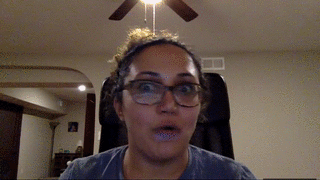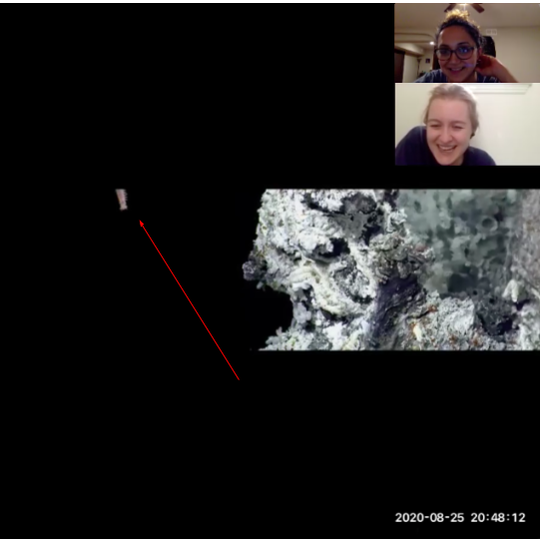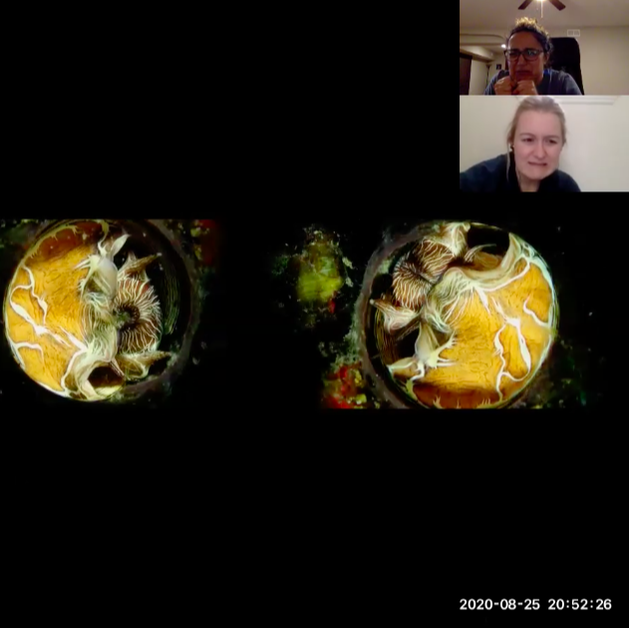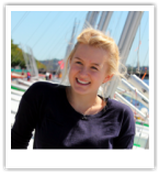Last week I had the absolute pleasure of learning more about Professor Aida Farough's dive in the submarine Alvin to explore deep-sea hydrothermal vents on Pacific Ocean floor. Aida is a fellow scientist on the Pisces VI Deep Sea Submarine crew; you'll quickly see why she's a favorite lecturer among students at Kansas State University. Her excitement for marine geology (aka, rocks on the seafloor) is contagious.
We recorded our chat so I could grab a short snippet for a presentation, but when I went back through the recording, I found tons of other great moments too good not to share.
We recorded our chat so I could grab a short snippet for a presentation, but when I went back through the recording, I found tons of other great moments too good not to share.
| laughing... | smiling... | grimacing... |
In December 2018, Aida joined the NSF-UNOLS Early Career Scientist Training Cruise. NSF is the National Science Foundation, and UNOLS is the University National Oceanographic Laboratory System. Here's Aida's explaining the cruise in her own words (0:00-2:10):
| They visited a vent referred to as 'EPR 9 50 North'. Aida rattles this off as if it's easy to say! EPR stands for East Pacific Ridge, and '9 50 North' refers to the location's latitude (9°50'). Aida's dive location was approximately 2.5 km deep, "one of the shallowest spots on the mid ocean ridge," she explained. I laughed because I don't often get to hear the word shallow next to 2.5 km deep. For reference, my PhD research focused on shallow reefs 18m deep -- yet Aida was 140x deeper! Alvin's maximum depth is 6.5 km, so Aida and team were well within this limit, but still deeper than only a few humans have explored. Aida's dive objectives spanned disciplines including petrology, geophysics, and biology (micro and macro). Additionally, an artist and science communicator aboard the cruise used some of their footage. Because they were the first team to visit the vent since the previous cruise, their initial objective was to look for indications of eruption; it had not. Aida listed a few of the tasks they accomplished on her dive: they deployed thermal blankets to measure heat and placed tiny buckets for microorganisms to grow upon that will be picked-up in later dives; they collected crabs, tube worms, and rocks from various portions of the vent. Aida's specific project was to deploy thermistors that would measure heat coming off the crust. She needed to find a flat spot on the ridge to leave the sensors for several months, until another expedition could retrieve them, even though there were no guarantees. "It was a big risk, but it was wonderful because now we have three months of data." Ten years before Aida's dive, scientists had left measurement instruments at the very same vent, and an unexpected eruption engulfed the sensors in lava. You may be thinking "oh no!" like I was, but Aida explained how the scientists flipped this into an opportunity for discovery. The Alvin submarine was able to pull some of the instruments, even just their SD cards, from the site. "A couple of Nature papers came out of it, because they had real-time seismic recordings of when an eruption actually happened at the ridge." | Quick Timeline of the Dive Decent: 1hr Exploring the vent: 6 hrs Assent: 1hr They did take a break to have sandwiches and coffee for lunch. I had to ask :) |
See why I was startled when Aida answered, "it'd be freakin awesome" to my question:
And can you guess what story led to this sequence of hand gestures? Answer 3:37 - 5:07 in video.
"I'm still working on the data, but I don't stop talking about the dive because it was such a critical point in my career. I've been studying hydrothermal vents since 2010. I received my masters and hD without being able to see a hydrothermal vent up close. Being given that opportunity was huge for me. It made everything fall into place for me, like pieces of a puzzle. "
I kept thinking of Michelle Obama's quote: "If something good happens to you, if you have an advantage - you don't hoard it. You share it, you give back." This is the hundredth time Aida has talked about her Alvin dive. I'm sure she's spent plenty more time talking about it than the dive itself, which was only eight hours. For more details on the dive, you could watch her post-dive interview, Woods Hole's live camera, read her blog post or website. I believe that if we think studying climate change and understanding our ocean is important, then we need a fleet of scientists making a living out of it. It can be tough to have the patience and persistence to stick with it. I haven't seen many scientists more dedicated and devoted to deep sea exploration than those like Aida who spent just eight hours in a deep-sea submarine like Alvin. It almost guarantees you'll stay in the field.
I kept thinking of Michelle Obama's quote: "If something good happens to you, if you have an advantage - you don't hoard it. You share it, you give back." This is the hundredth time Aida has talked about her Alvin dive. I'm sure she's spent plenty more time talking about it than the dive itself, which was only eight hours. For more details on the dive, you could watch her post-dive interview, Woods Hole's live camera, read her blog post or website. I believe that if we think studying climate change and understanding our ocean is important, then we need a fleet of scientists making a living out of it. It can be tough to have the patience and persistence to stick with it. I haven't seen many scientists more dedicated and devoted to deep sea exploration than those like Aida who spent just eight hours in a deep-sea submarine like Alvin. It almost guarantees you'll stay in the field.
If you wish to learn more about Alvin, I suggest two books: Water Baby: The Story of Alvin by Victoria A. Kaharl, and The Octopus's Garden by Professor Cindy Lee Van Dover. Both are written in an engaging, approachable manner.





 RSS Feed
RSS Feed
